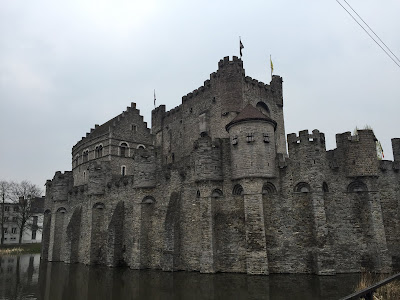Wednesday, May 1, 2019
Ghent, Belgium
We spent the afternoon of Day 7 in Ghent, Belgium exploring on our own and having a great time! Ghent is not far from Bruges but is a little less touristy and it was less crowded. We had a very nice afternoon!
Ghent has a long and colorful history. It was an important port and center of the flower seed and bulb trade, but is best known as the site of the signing of the Treaty of Ghent that ended the War of 1812 between Britain and the United States.
St. Bavo's Cathedral's current Gothic structure was completed in 1559, with remnants still remaining from the original 10th-century church consecrated here and the 12th-century Romanesque church that followed. It was originally named for St. John the Baptist but was renamed after its completion after St. Bavo, a 7th-century nobleman who was canonized after he gave away all of his possessions to the poor and entered a monastery.
We took a ride in a canal boat and were the only English speakers. The driver/guide asked everyone as they got on what language they spoke and he ended up giving the tour in Dutch, French and English - just easily transitioning from one to the other. I was impressed!
Gravensteen Castle (Gravensteen is Dutch fo "Castle of the Counts")
It was built in 1180 by Philip of Alsace, Count of Flanders. In the 14th century the seat of the Count of Flanders was relocated and the castle served as a court of law and a prison until the late 18th century, when it was sold and turned into an industrial complex. In the 19th century it was acquired by the Ghent City Council and restored back to its medieval glory.
Besides some delicious hot chocolate, we had to try Belgian Liege waffles. I, of course, had even more chocolate on mine 😋
Sadly we missed the Mystic Lamb Altarpiece in St. Bavo's Cathedral by 10 minutes! (I guess we'll have to go back!). We did get to tour the inside of the cathedral but they had already closed the altarpiece viewing by the time we got there.
Interesting facts learned from our Viking Daily:
The Adoration of the Mystic Lamb is a 12-panel polyptych by Jan and Hubert van Eyck. It is one of the most important artworks in European history and also the most stolen painting in art history.
Originally located in a smaller chapel, the piece was moved to St. Bavo's main chapel after many looting attempts. It included clockwork mechanisms for moving the shutters and playing music, but these were taken during the Reformation. In 1816, a Berlin collector bought several panels: during World War I, the Germans stole others. They were mandated to return everything as part of the Treaty of Versailles and did so... One of its lower panels was stolen in 1934 and never recovered. As World War II loomed, Belgian authorities tried to move the altarpiece to the Vatican for safekeeping, but had to detour to a Pyrenees hiding place when Italy declared war. The painting was seized by Hitler in 1942 and brought to a Bavarian castle, where Allied Air raids soon forced its further removal. In 1945, it was discovered in an Austrian salt mine by the Allied treasure-hunting group called the Monuments Men. What a history!!
This is Mike's Liege waffle - I didn't eat two, although they were yummy enough.
Another fun and beautiful day! I hope you're having a great day today! I am going to go to my granddaughter's soccer game 😁
Subscribe to:
Post Comments (Atom)

























No comments:
Post a Comment